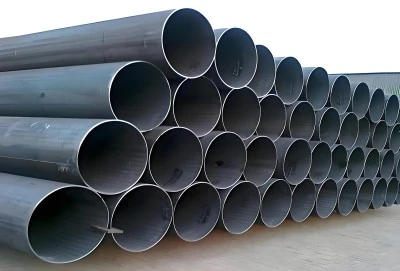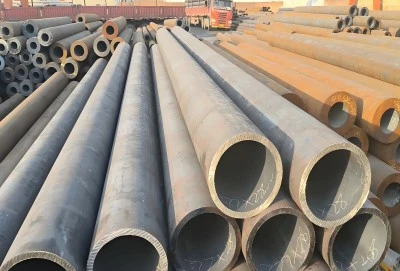In the world of steel manufacturing and construction, understanding the differences between various steel grades is crucial for selecting the right material for specific applications. Two commonly used steel grades in structural projects are S235 and A36. While they may seem similar at first glance, these steel grades have distinct characteristics that set them apart. In this comprehensive guide, we'll explore the differences between S235 steel pipe and A36 pipe, focusing on their chemical compositions, mechanical properties, and interchangeability in structural projects.
|
|
|
How do the chemical compositions of S235 and A36 differ?
The chemical composition of steel plays a significant role in determining its properties and performance. S235 and A36 steel grades have different chemical compositions, which contribute to their unique characteristics:
S235 Steel Composition:
- Carbon (C): 0.17% max
- Manganese (Mn): 1.40% max
- Silicon (Si): 0.35% max
- Phosphorus (P): 0.040% max
- Sulfur (S): 0.040% max
A36 Steel Composition:
- Carbon (C): 0.26% max
- Manganese (Mn): 0.60-0.90%
- Silicon (Si): 0.40% max
- Phosphorus (P): 0.040% max
- Sulfur (S): 0.050% max
One of the most notable differences is the carbon content. S235 steel pipe has a lower maximum carbon content (0.17%) compared to A36 steel (0.26%). This difference in carbon content affects the strength and weldability of the materials. S235 steel, with its lower carbon content, generally offers better weldability and formability, making it suitable for applications where these properties are crucial.
The manganese content also differs between the two grades. S235 steel pipe has a higher maximum manganese content (1.40%) compared to A36 steel (0.60-0.90%). Manganese contributes to the strength and hardenability of the steel, and the higher content in S235 helps compensate for its lower carbon content.
It's important to note that while these are the general composition ranges, specific heats or batches of steel may have slight variations within these limits. These variations can lead to subtle differences in properties even within the same grade.
What are the key mechanical property differences between S235 and A36 steel pipes?
The mechanical properties of steel are crucial for determining its performance in various applications. S235 and A36 steel pipes exhibit different mechanical properties due to their distinct chemical compositions and manufacturing processes:
Yield Strength:
- S235 steel: Minimum yield strength of 235 MPa (34 ksi)
- A36 steel: Minimum yield strength of 250 MPa (36 ksi)
A36 steel has a slightly higher yield strength, which means it can withstand more stress before permanent deformation occurs. This makes A36 steel pipes potentially more suitable for applications requiring higher load-bearing capacity.
Tensile Strength:
- S235 steel: Tensile strength range of 360-510 MPa (52-74 ksi)
- A36 steel: Tensile strength range of 400-550 MPa (58-80 ksi)
A36 steel generally has a higher tensile strength range, indicating that it can withstand greater forces before failure. This property makes A36 steel pipes suitable for applications where high tensile strength is required.
Elongation:
- S235 steel: Minimum elongation of 26% (for thicknesses ≤ 16mm)
- A36 steel: Minimum elongation of 20% (for 8-inch test length)
S235 steel typically exhibits higher elongation, which indicates better ductility and formability. This property makes S235 steel pipes more suitable for applications requiring complex shaping or bending.
Impact Toughness:
S235 steel is often available in grades with specified impact toughness (e.g., S235J0, S235J2), which is particularly important for applications in low-temperature environments or where sudden impact loads may occur. A36 steel does not have specified impact toughness requirements in its standard specification.
Weldability:
Due to its lower carbon content, S235 steel generally offers better weldability compared to A36 steel. This makes S235 steel pipes a preferred choice in applications where extensive welding is required.
These mechanical property differences highlight that while both S235 and A36 steel pipes are suitable for structural applications, they may be preferred in different scenarios based on specific project requirements.
Is S235 steel pipe interchangeable with A36 pipe in structural projects?
The interchangeability of S235 steel pipe and A36 pipe in structural projects is a complex issue that depends on various factors. While both are widely used in construction and have similar applications, they are not always directly interchangeable without careful consideration:
Strength Considerations:
A36 steel has a slightly higher yield strength (250 MPa) compared to S235 steel (235 MPa). In projects where the design is based on the yield strength of A36, direct substitution with S235 may not be appropriate without re-evaluation of the structural calculations. However, in many cases, the difference is small enough that S235 can be used as a substitute, especially if there's a safety factor built into the design.
Code Compliance:
Different regions and countries may have specific building codes and standards that dictate which steel grades can be used in certain applications. For instance, A36 is more commonly specified in North American standards, while S235 is more prevalent in European standards. Substitution may require approval from the relevant authorities or engineering professionals.
Weldability and Fabrication:
S235 steel, with its lower carbon content, generally offers better weldability compared to A36. In projects where extensive welding is required, S235 might be preferred. However, both grades are considered to have good weldability, and the difference may not be significant in many applications.
Temperature Performance:
For projects in low-temperature environments, S235 steel is available in grades with specified impact toughness (e.g., S235J0, S235J2). A36 does not have this specification in its standard. In cold climate applications, S235 with appropriate impact toughness may be preferred over A36.
Availability and Cost:
The availability and cost of S235 steel pipe versus A36 pipe can vary depending on the region and market conditions. In some areas, one grade may be more readily available or cost-effective than the other, which could influence the choice between the two.
Project Specifications:
Many projects have specific material requirements outlined in their specifications. Substituting one grade for another would require approval from the project engineer or client and may necessitate a change order.
Corrosion Resistance:
Both S235 and A36 have similar corrosion resistance properties. However, if the project requires enhanced corrosion resistance, specialized coatings or alternative grades might be necessary regardless of whether S235 or A36 is chosen.
Contact Longma Group
In conclusion, while S235 steel pipe and A36 pipe share many similarities and can be interchangeable in some applications, it's crucial to evaluate each project's specific requirements before making a substitution. Factors such as structural calculations, welding requirements, temperature performance, and local building codes must be carefully considered. In many cases, the substitution may be possible with proper engineering review and approval.
For projects requiring high-quality S235 steel pipe, Longma Group is a leading manufacturer in China. With a wide range of products including S235JRH/J0H/J2H grades, outer diameters from 4" to 56", and thicknesses from 0.237" to 5.90", Longma Group can meet diverse project needs. Their commitment to excellence ensures that customers receive top-notch products suitable for various structural applications. For more information or to discuss your specific pipe requirements, don't hesitate to get in touch with Longma Group at info@longma-group.com. Their team of experts is ready to assist you in selecting the right steel pipe for your project.














